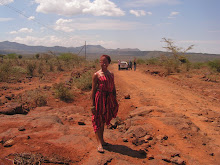Africa
and the Rest of the World before Miley Cyrus
I am a dancer. I love to
dance and welcome all styles of dance. The process of choreography is a work of
art. The expression of dance as a free form is also beautiful. Whether within
the boundaries of technique or expressed through free movement I feel like the
winds have carried me to a realm beyond what is present when I dance and/or
observe it in motion. Self-expression
through dance for me is ecstasy.
The topic of twerking has
been a subject of conversation amongst those well-versed in American pop
culture. The beautiful, Disney-like Miley Cyrus seems to be experiencing a type
of delayed teenage rebellion and is staging her about-face for the whole world
to see. Besides making out with Barbie, licking sledge hammers and other weird
antics in her music videos, “We Can’t Stop” shows Miley, several black women
and a few strange teddy bears gyrating their butts to the beat of the music.
Thus twerking was born.
Or was it? Across the Continent
of Africa there are numerous traditional dances where the focal points are the
waist and but movement. The rhythmic, gyrating of a woman’s lower waist to the
beat of a drum is a cultural expression of fertility, culture and celebration
that existed before Miley Cyrus. Though the dances and the purpose of these
lower-waist movements vary from culture to culture, gyrating or ‘twerking’ is common
to Africans and Afro-Caribbean peoples all over the world.
There has never been an
outcry for Africans to stop gyrating their waists for fear of corrupting the
word’s youth. These dances were, and in
some communities still are an integral part of community life. Culture is
sacred. Life is sacred. Celebrations and cultural festivals are sacred. This
was the heart of the matter. So what’s
the deal with twerking?
Traditional African dances. The Origin of
twerking?
Ivory Coast
Uganda
For me there is no ‘dirty
dancing’ vs ‘clean dancing’. The audience may respond differently to various
types of choreography but as an artist I realize that the viewers will derive
their own interpretation of the artistic forms that they experience. Art itself leaves the interpretation up to
the viewer.
Twerking has left a bitter
taste in our mouths not entirely because of the movement itself but because of
what came with it-the loss of Hollywood’s ‘nice girl’ to a sledge-hammer
licking, drug addicted, naked ball-swinging monster.
I grew up dancing in
church. We wore long, white robes and danced with our upper body most of the
time. Waists remained silently still. Hands waving in circular praise movements
and bowing in prayer posture were frequent elements of the choreography. This
type of dance was considered to be ‘clean dancing’.
I remember when I returned
from college after training for a couple years with professional dancers. I did many leaps, jumps and turns in my choreography
during my performance. I was happy. My heart felt golden. Until I watched the programme
air on TV and saw that the editor had flashed out all of my leaps and jumps.
The reason? I lifted my leg in church. How undignified.
The clear cut lines
between the secular and the sacred are not as clearly defined in life and in
artistic expression as we would like to believe. Sacred is the heart of the
person. Sacred is authenticity of a heart that respects the counsel of their
elders, feels the love of their friends and endeavors to do good to all
humanity. Sacred is the person who feeds the needy, continues to learn and grow
and is able to say, “I’m sorry” from a genuine heart.
After Miley disappears from the world’s stage
and everyone has forgotten about the strange teddy bears, women will continue
to dance with their lower waists to the beat of a drum somewhere in the world
as they have done for millennia. Life is dance. All life is beautiful. Dance is
transcendent. Before Miley there was twerking.
